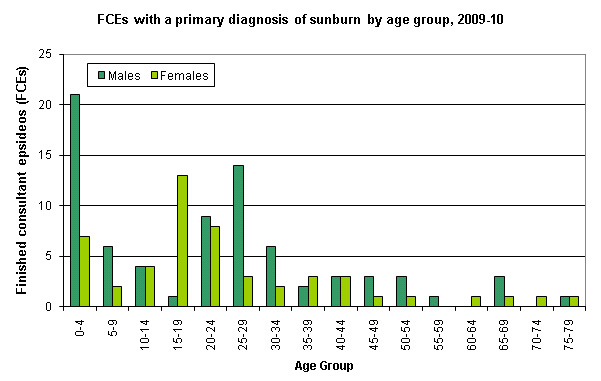IN THIS SITE...

- NHS Choices: Sunburn
- SunSmart
- Inpatient Data
- Self Service
HES on... Sunburn
Sunburn affects all people of all ages. This article gives an overview of HES data relating to patients who have been admitted to hospital in England after being burnt.
What is sunburn?
Sunlight contains ultraviolet light (UV). When skin is exposed to too much UV it can overheat, become red and painful, and peel or blister. This is sunburn.
Sunburn, as with all burns, can be categorised as first, second or third degree (L55.0, L55.1 and L55.2 respectively in ICD-10).
Who does it affect?
Sunburn can affect anyone of any age, a finding that HES data confirms (see graph of 2009-10 data below). However, individuals with less melanin (a pigment produced by skin to help protect against UV) are less protected and more likely to be burnt.
 |
HES facts and figures
HES data for sunburn (diagnosis code L55 in ICD-10) shows that:
- most (93 per cent) hospital admissions for sunburn are emergency admissions, rather than from waiting lists
- the average (mean) time that patients remained in hospital was 1.1 days
- the majority (90 per cent) of patients admitted to hospital for sunburn don't undergo procedures. Of those that do, the most common procedure carried out was an exploration of burnt skin of other site (S55 in OPCS-4.6)
- it was responsible for 128 episodes of admitted patient care, accounting for 137 occupied bed days
- twenty per cent of those treated for sunburn had first degree burns (26 FCEs). A further 25 per cent (32 FCEs) were treated for second degree burns, with the remaining unspecified.
More information on this topic is available from NHS Choices here.

